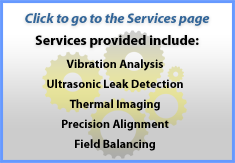







Predictive Maintenance offers expertise service in Vibration Analysis, Ultrasonic Leak Detection, Thermal Imaging, Precision Alignment, Field Balancing and Industrial Oil Analysis. Predictive Maintenance provides clients with detailed reports of each analysis or evaluation. In addition, Predictive Maintenance has a zero incident rating and is licensed and insured.


Vibration Analysis
A non-destructive testing method that can provide a reduction in maintenance costs and equipment downtime by detecting equipment faults. Testing includes recording and analysis of vibration on industrial rotating machines, such as fans, pumps, gear reducers, chillers, or agitators.


Ultrasonic Leak Detection
A non-destructive testing method for detecting compressed air or gas leaks whether underground or air borne. Miniscule leaks as low as 1 psi can emit a sound frequency too high for ears to detect. Testing translates this sound to a lower frequency which can be heard through headphones.


Thermal Imaging
A non-destructive testing method for evaluating temperatures of electrical components in high voltage electrical cabinets. Imaging helps detect hotspots, overloaded circuit breakers, leaks in sealed vessels, faulty terminations in circuits, and other electrical issues. Imaging provides unit measurement versus spot measurement.


Precision Alignment
Misalignment is the leading cause of bearing failure. Precision alignment is a corrective maintenance process that maximizes coupling life, decreases bearing load, reduces detrimental resonant vibration, and lowers energy cost. With proper alignment, the life of new and existing rotating machines can be extended.


Field Balancing
Unbalance is a major cause of damage in rotating equipment. Field balancing uses vibration and phase measurements to determine the location of unbalance. This, along with software and experience, is how we locate the angle and amount of weight to add to correct the unbalance and reduce vibration to a minimum


Industrial Oil Analysis
A non-destructive testing method for obtaining machine oil which is then analyzed for the presence and level of suspended contaminants and wear debris. When tracking results over the life of a machine, data trends are established which can determine the remaining life of the oil and help reduce repairs costs.
